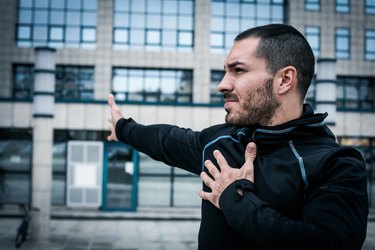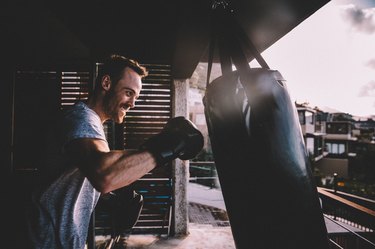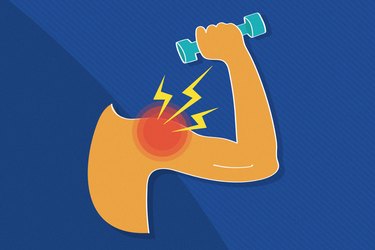
Sore arms and biceps after a challenging upper-body workout is normal — maybe even to be expected. After all, sore muscles are a part of the natural muscle-repair process that ultimately makes you stronger.
But some people experience a strange post-exercise phenomenon that goes beyond basic aches and pains. After lifting weights — usually a hefty dose of biceps and pulling exercises — they find they can't straighten their arms all the way. Their elbows just won't do it.
Video of the Day
Experiencing lasting biceps pain, especially when you can't straighten your arm, is generally rooted in extra inflammation and damage (typically the result of new stress placed on your biceps muscles.) But what can you do to relieve the discomfort? And how do you prevent it in the future?
Below, find out why you might not be able to straighten your arms after a workout and what you can do to resolve the issue.
1. Delayed-Onset Muscle Soreness
Doing a tough workout causes micro-tears within your muscle fibers, leading to delayed-onset muscle soreness, or DOMS, a day or two after intense exercise.
"To repair the damage done to the neuromuscular system, blood flow to the area increases," says Todd Buckingham, PhD, lead exercise physiologist for the Mary Free Bed Sports Performance Lab. "This creates inflammation and edema, or swelling."
Ultimately, the increase in circulation is a good thing, because your blood carries nutrients that aid in healing. "It regenerates muscle tissue, increasing performance and overall strength," says Jonathan Mike, PhD, a professor of exercise science and sports performance at Grand Canyon University.
But it can also come with some less-than-pleasant side effects. The inflammation from extra blood flow pushes on your nerves, Buckingham says. That's why your muscles feel so tender.
The pain and swelling in your arms, in turn, can prevent you from fully straightening your elbow joint. Once you reach a certain point, the pressure against your nerve fibers is so intense that your brain tells your arm not to straighten any more. (This all happens in your autonomic nervous system, so it's not something you can consciously control.)
Inflammation can physically limit your range of motion by several degrees, Buckingham says. "The inflammation acts like a blockade preventing you from full extension."
2. Cellular Damage
Another potential cause of not being able to extend your elbow: damage to the structures supporting your biceps muscles.
"Each of your muscle cells has a net-like structure surrounding it, called the sarcoplasmic reticulum [SR]," Buckingham says. The SR plays a vital step in allowing you to both contract and relax your muscles. It releases calcium into your muscle cells, with that calcium acting like the key that unlocks your muscles and allows them to move. So, to lengthen your biceps muscles and extend your arms, the SR has to release calcium.
"But if you damage your SR during heavy exercise, it won't release calcium and so there won't be any relaxation of the muscle," Buckingham says. "This can lead to stiffness and pain and can prevent you from straightening out the muscle."
3 Workout Habits That Lead to Biceps Pain
Experiencing lasting biceps pain, especially when you can't straighten your arm, is generally rooted in the inflammation and damage detailed above. But it's often the result of a few common scenarios you may encounter during your workout:
1. You Pushed Too Hard
Overdoing it during a workout increases the chance of being unable to elongate your muscles afterward.
"If a muscle is stressed past its limits due to repeated contractions against a heavy load, it causes neuromuscular injury," Buckingham says. "This is an indication that you went too hard, so back off a bit next time."
Upping the intensity little by little will lead to better long-term results. Moving forward, be sure to increase the intensity of exercise in a stepwise fashion, so that you're not loading on more than you can handle.
2. You Tried New Exercises
Along those lines, if you haven't worked out in a while or you do a different type of workout than usual (say, you go to your first barre class, or lift weights for the first time in ages), you're also at greater risk of inner elbow pain.
"When you are unaccustomed to the activity, you will experience more micro-tears in your muscles than if it's something you do routinely," Buckingham says. "The reason is that your muscles have to build themselves up stronger so that the next time you do the same activity, they won't have as much damage."
There's no reason to avoid new exercises (unless they aggravate a current injury or lead to a new one). Just ease into them.
3. You Worked Your Muscles Eccentrically
Pain and difficulty extending your arms is also more likely to happen after exercises that involve eccentric actions. "Eccentric contraction is the forced lengthening of a muscle," Buckingham says.
For instance, during hammer curls, raising your hand up to your shoulder is a concentric action or contraction — your biceps muscle is getting shorter. Holding the dumbbell in place at the top of the lift is an isometric contraction, meaning there is no change in muscle length. When you lower your hand back down, this is an eccentric contraction, elongating your muscle.
"Eccentric contractions produce the most muscle damage, because you are working against gravity," Buckingham says. "Instead of simply letting your hand fall down to your side, you have to control the descent."
Eccentric exercises are great for building muscle, so don't feel like you have to avoid them. Instead, limit how many eccentric exercises you do in a given workout. Try limiting yourself to one per workout before increasing further.
When to Talk to a Doctor
Should you be worried about not being able to straighten your arms? Not necessarily — it's normal to be a little sore after a workout. As long as it clears up within 48 hours or so, you should be fine.
That said, it probably means you pushed yourself too much. After all, if you're so sore or your movement is inhibited to the point where you can't work out for days, you're missing out on the benefits of regular exercise.
"Consistency is key if you want to see improvements in fitness," Buckingham says.
If your symptoms linger longer than two days, you should get checked out by a doctor to rule out more serious conditions like rhabdomyolysis (often nicknamed "rhabdo").
"Rhabdomyolysis is when you have extreme damage to the muscle," Buckingham says. "It breaks down and releases proteins into the blood, which can harm your heart and kidneys, and is potentially life-threatening." Signs of rhabdomyolysis include dark red or brown urine, severe muscle aches and weakness.
Also consider talking to your doc if you have severe or long-lasting inner elbow pain. This may indicate a tendon injury, Buckingham says. You may have strained the tendon that attaches your biceps muscle to the bones — luckily, this usually resolves on its own.
"It could also be a condition called tennis elbow," Mike says. "It is often due to overuse of the forearm muscle and is extremely treatable." The vast majority of people with tennis elbow feel better with rest, over-the-counter pain meds and physical therapy, according to the American Academy of Orthopaedic Surgeons.
When Will I Be Able to Straighten My Arm Again?
Most likely in a day or two. Still, things could draw on a bit longer, depending on the type and overall volume of your recent training session, Mike says. “It also depends partly on genetics, and partly on how well you are resting and recovering," Buckingham adds.
If you're so sore that you can't move, it's probably best to consult a medical professional, as you may have injured yourself during your workout.
Treatment and Prevention Tips
If you're sure you're dealing with normal soreness and don't need to see a health care professional, you can try these treatment (and prevention) suggestions on your own.
1. Adjust Your Workout
Doing too much too soon is a common cause of muscle soreness and stiffness (especially for beginners). So, the best long-term solution is to back off of your exercise intensity. Lower the weights you're lifting and/or lower your number of sets and reps. A good rule of thumb: The last two reps of each set should feel comfortably challenging.
Then, over time, slowly progress so your muscles are able to adapt, recover and grow back stronger between each lifting session. Generally, you shouldn't increase your training volume by more than 10 percent each week, according to the National Academy of Sports Medicine.
2. Move and Stretch
Wondering if you should work out while you're sore? Don't jump right into another training session, but it's OK to keep moving. "Doing gentle range-of-motion movements will increase blood flow to the affected area and aid in recovery," Buckingham says.
He suggests repeating the same type of movements that caused the issue, only without weights. So if you can't straighten your arm, try the following: biceps curls, triceps extensions, arm circles, shoulder presses and Y raises.
Stretching can also help relieve post-workout aches and pains, according to the American Council on Exercise (ACE). Running through a few dynamic arm stretches (like the moves below) can help promote blood flow and recovery to your sore muscles.
Overhead Dynamic Triceps Stretch
- Raise your left arm straight above your head and bend your elbow to lower your palm to your back.
- Place your right hand near your raised elbow and gently pull it toward your body and down.
- Pause, then release and straighten your arm back overhead.
- Continue for 30 seconds.
- Repeat on the other side.
Wrist Flexion and Extension Drill
- Hold your left arm straight out in front of your body at shoulder height with your palm facing up.
- With your right hand, pull back on the fingers of your left hand to feel a gentle stretch in your left forearm.
- Hold here for 10 to 15 seconds.
- Use your right hand to gently pull your left palm toward you.
- Hold here for 10 to 15 seconds.
- Repeat on the other side.
Forward Overhead Swing
- Start by standing with your arms by your sides and your feet about shoulder-width apart
- Take one small step forward with your left foot as you swing both arms overhead.
- Swing your arms back down as you step back.
- Repeat, this time stepping forward with your right foot.
- Continue alternating feet for 30 seconds.
3. Refuel
When you strength train, your muscles use stored carbohydrates for energy, according to the ACE. So, it's important to prioritize nutrient-dense carb sources (like oats or sweet potatoes) to replenish your sore muscles.
You also want to make sure you're getting enough protein. Protein helps repair exercise-induced muscle damage, which is how you get stronger. Wondering how much protein to eat? Aim for 1.4 to 2 grams of protein per 2.2 pounds of body weight a day.
Here's how to calculate that benchmark:
- Divide your weight in pounds by 2.2.
- Multiply that number by 1.4. That's the low end of your protein intake range.
- Divide your weight in pounds by 2.2.
- Multiply that number by 2. That's the high end of your protein intake range.
For example, if you weigh 180 pounds, you'd aim for 114 to 164 grams of protein per day. For easier math, many people simply plan to eat 1 gram of protein for every pound of their body weight each day.
Your Complete Guide to Workout Recovery
- MedlinePlus: "Rhabdomyolysis"
- Mayo Clinic: "Golfer's Elbow"
- ACSM: "Delayed Onset Muscle Soreness"
- Journal of Strength and Conditioning Research: "Causes of Delayed Onset Muscle Soreness"
- American Academy of Orthopaedic Surgeons: "Tennis Elbow (Lateral Epicondylitis)"
- NASM: "Progressive Overload Explained: Grow Muscle & Strength Today"
- ACE: "Strength Training Post-Workout Nutrition Guidelines"
- ACE: "Top 10 Benefits of Stretching"







